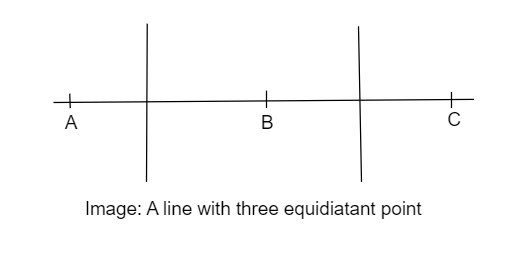
Find the locus of a point equidistant from three collinear points.
A. A straight line
B. A pair of points
C. A point
D. The null set
Answer
216.3k+ views
Hint: Draw a line and place three collinear points in it. Then draw a perpendicular bisector between each of three points. Then obtain the locus of the points with the help of these perpendicular bisectors.
Complete step by step solution:
The diagram of the three equidistant point of a line with perpendicular bisector is,

We know that a line through the point of intersection of the perpendicular bisector gives the locus of three equidistant collinear point, but from the diagram it is clear that there is no point of intersection of these two perpendicular bisectors as they are parallel lines.
Hence, the locus is a null set.
Option ‘D’ is correct
Additional information
In geometry, a locus is a collection of points that satisfy a particular requirement or circumstance for a shape or figure. The locus is pluralized as loci. The region is the space where the loci are located. Location is the ancestor of the word locus. Prior to the 20th century, geometric shapes were thought of as things or locations where points might be put or moved. However, in contemporary mathematics, the entities are seen as a collection of points that satisfy a particular condition.A locus is a curve or other shape created in mathematics from all the points that meet a specific equation describing the relationship between the coordinates, or from a point, line, or moving surface. The locus defines all shapes as a set of points, including circles, ellipses, parabolas, and hyperbolas.
Note: Sometimes students get into the calculation part and are unable to find the answer, so for this type of question draw a diagram and give the answer logically.
Complete step by step solution:
The diagram of the three equidistant point of a line with perpendicular bisector is,

We know that a line through the point of intersection of the perpendicular bisector gives the locus of three equidistant collinear point, but from the diagram it is clear that there is no point of intersection of these two perpendicular bisectors as they are parallel lines.
Hence, the locus is a null set.
Option ‘D’ is correct
Additional information
In geometry, a locus is a collection of points that satisfy a particular requirement or circumstance for a shape or figure. The locus is pluralized as loci. The region is the space where the loci are located. Location is the ancestor of the word locus. Prior to the 20th century, geometric shapes were thought of as things or locations where points might be put or moved. However, in contemporary mathematics, the entities are seen as a collection of points that satisfy a particular condition.A locus is a curve or other shape created in mathematics from all the points that meet a specific equation describing the relationship between the coordinates, or from a point, line, or moving surface. The locus defines all shapes as a set of points, including circles, ellipses, parabolas, and hyperbolas.
Note: Sometimes students get into the calculation part and are unable to find the answer, so for this type of question draw a diagram and give the answer logically.
Recently Updated Pages
JEE Atomic Structure and Chemical Bonding important Concepts and Tips

JEE Amino Acids and Peptides Important Concepts and Tips for Exam Preparation

Electricity and Magnetism Explained: Key Concepts & Applications

Chemical Properties of Hydrogen - Important Concepts for JEE Exam Preparation

JEE Energetics Important Concepts and Tips for Exam Preparation

JEE Isolation, Preparation and Properties of Non-metals Important Concepts and Tips for Exam Preparation

Trending doubts
JEE Main 2026: Application Form Open, Exam Dates, Syllabus, Eligibility & Question Papers

Derivation of Equation of Trajectory Explained for Students

Hybridisation in Chemistry – Concept, Types & Applications

Understanding the Angle of Deviation in a Prism

Understanding Collisions: Types and Examples for Students

How to Convert a Galvanometer into an Ammeter or Voltmeter

Other Pages
JEE Advanced Marks vs Ranks 2025: Understanding Category-wise Qualifying Marks and Previous Year Cut-offs

Understanding Atomic Structure for Beginners

Ideal and Non-Ideal Solutions Explained for Class 12 Chemistry

Degree of Dissociation: Meaning, Formula, Calculation & Uses

Understanding Electromagnetic Waves and Their Importance

Understanding the Electric Field of a Uniformly Charged Ring




